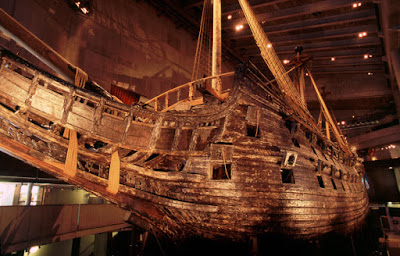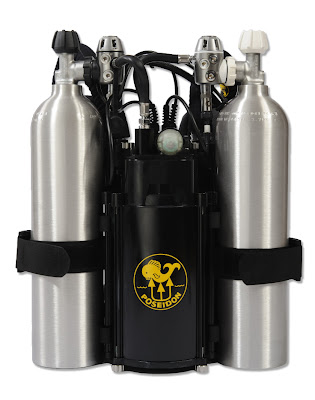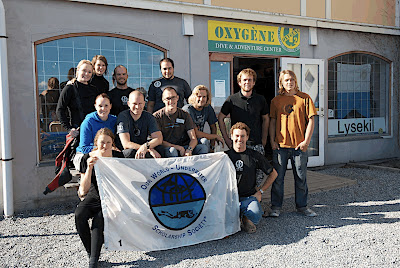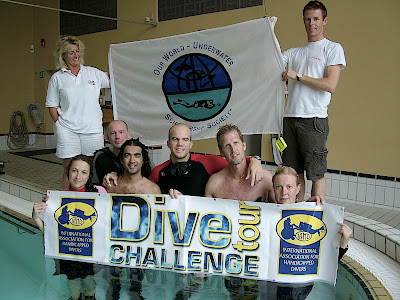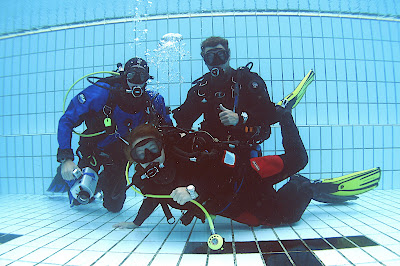Steve, Eline and I have finally been forced to depart Iceland, and have arrived safely in Göteborg, Sweden. Although we're excited to be visiting Sweden and hanging out with Johan and Delia, leaving Iceland was probably one of the harder things we've had to do this month. I think that all three of us would agree that a week was nowhere near long enough a stay, and I'd be very surprised if this was the last time I travelled to Iceland.
As previously reported, we were greeted at Keflavík by our awesome host Tobias Klose, owner of
DIVE.IS and driven into Reykjavík where we would stay for our first few days in Iceland. The next morning we were picked up by Louis Kotze, our divemaster to head over to
ϸingvellir. Louis is 23, from Namibia, and is finishing up his first season working as a divemaster in Iceland. We didn't know it then, but Louis would become a close friend of ours, and share in all of our Icelandic adventures. Generally regarded as Iceland's most important and popular national park because of its role as the earliest European parliament (930 AD), we were drawn by ϸingvellir's unique and incredible geology. The entire park is essentially a large rift valley sandwiched between ϸingvallavatn, Iceland's largest natural lake, and a dormant shield volcano, Skjaldbreiður and the glacier Langjökull.
ϸingvallavatn
The mid-atlantic ridge, the crack in the Earth's crust where the Eurasian and North American plates are separating, rises up above the ocean and passes directly through Iceland. The separation of the two plates is literally tearing apart the earth and has created ϸingvellir. The geology and flow of groundwater is something that's being carefully studied and debated but water that froze and became part of Langjökull over a thousand years ago melts and travels through the porous volcanic rock of the dormant volcano Skjaldbreiður at depths of 5-8 kilometers below the earth. After a journey of 50 years through the volcanic crust, this water emerges out of springs inside ϸingvellir, incredibly pure, and a bone chilling 2 degrees. Diving is permitted only in one of the spring systems, Silfra (Silver Lady in Icelandic). The water is shockingly cold, the view, above and below the water is so crystal clear and stunningly beautiful that it can be difficult to distinguish up from down, and we quickly learned that the best way to clear your snorkel is not to blow the water out, but simply to drink from it until you can breathe through it again. Diving in Silfra was an intense and incredible experience, and its hard to imagine diving anywhere more beautiful.
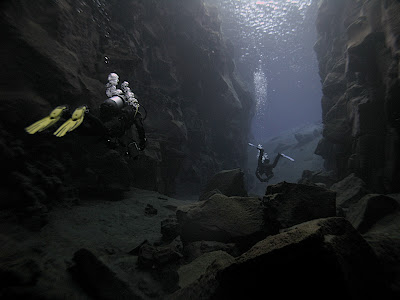
Silfra
During our time in Reykjavik, we also had a chance to meet with Tómas Knútsson, the founder of dive.is who has since moved on to founding and leading his own environmental movement in Iceland, the
Blái Herinn (Blue Army). Tommy was a really interesting guy to meet, and we had some good discussions about his views on environmentalism, youth and public opinion on the environment, and his own personal campaign for various environmental causes within Iceland. As a diver, he began the Blue Army as a project to clean up batteries from cars and boats that were being dumped in the ocean, but has broadened his efforts to a number of issues facing Iceland. He was a very inspirational guy, and I think he really made the other scholars and myself reaffirm our environmental convictions. We also took some time to visit Geysir and the waterfall Gullfoss with Louis before leaving Reykjavik for the north.
Gullfoss
Besides a short battle with a flat tire, we spent most of the 7 hour journey to Hauganes staring out the windows with our jaws on the floormats. I've probably mentioned it several times already, but I'll do so again; Iceland is incredibly beautiful and mysterious. We were there to dive on the Strýtans, a series of geothermal chimneys discovered in 70 meters of water on the bottom of Eyjafjörður on the northern coast of Iceland. We were also lucky enough to be joined by the commercial and scientific diver who had discovered the chimey,
Erlendur, and another local diver, Siggi.
Me, Eline, Erlendur (legendary), Steve and Lois
Although the visibility wasn't fantastic, we were able to remove our gloves in the 12 degree water and warm our hands in the 75 degree water flowing out of the vents. We also caught some beautiful cod and coalfish that proved to be delicious! On our last night in the north, we drove half an hour to Olafsfjörður for our last dive in Iceland. Siggi took us out on his boat to dive on a kelp forest. We also came upon a sperm whale which had died and washed up nearby. Although it was almost 10pm by the time we made our way back to the dock, the sun was just beginning to set, and I think that all of us were really stuck by the beauty surrounding us, and how lucky we were to be traveling and diving in such an incredible place with such awesome people.
Icelandic Sunset
We were able to squeeze in one last evening free-diving trip to Silfra with Louis before our flight back to Göteborg. I'm confident that we'll make more friends like Tobias and Louis during our travels, but all three of us had knots in our stomachs as we boarded our flight to Sweden. With any luck this won't have been the last time we visit Iceland.
